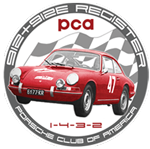I n
the world of sports cars, the Porsche 911 and its variants have long
been viewed as genuine classics. Combining both modern and
traditional elements, their family tree can be traced back to
legendary forebears, from the Porsche Type 356 model (78,000
constructed) to the Volkswagen Beetle (another Porsche design). As
the 356 successor, expectations were high from the onset of design;
Porsche needed a state-of-the-art car, even better, one ahead of its
time. The design of the car goes back to Ferdinand Alexander
Porsche, the eldest son of Ferry Porsche, at the time the President
and Chief Executive Officer of what was then Porsche KG. A
25-year-old designer back in those days, F. A. Porsche later
remembered the great task of creating a successor to the Porsche
356: "The job was not to simply design some kind of new car within a
large model range. No - this was to be the successor to a car which
itself had become a classic after more than 1 1/2 decades in the
market." He described the 911 as a sports car with a clear and
honest form, stating just as clearly that "a good product must be
discreet in its good looks. Design is not fashion". n
the world of sports cars, the Porsche 911 and its variants have long
been viewed as genuine classics. Combining both modern and
traditional elements, their family tree can be traced back to
legendary forebears, from the Porsche Type 356 model (78,000
constructed) to the Volkswagen Beetle (another Porsche design). As
the 356 successor, expectations were high from the onset of design;
Porsche needed a state-of-the-art car, even better, one ahead of its
time. The design of the car goes back to Ferdinand Alexander
Porsche, the eldest son of Ferry Porsche, at the time the President
and Chief Executive Officer of what was then Porsche KG. A
25-year-old designer back in those days, F. A. Porsche later
remembered the great task of creating a successor to the Porsche
356: "The job was not to simply design some kind of new car within a
large model range. No - this was to be the successor to a car which
itself had become a classic after more than 1 1/2 decades in the
market." He described the 911 as a sports car with a clear and
honest form, stating just as clearly that "a good product must be
discreet in its good looks. Design is not fashion".
Yet
Porsche's traditional concept was to be almost unchanged: a
high-performance flat engine fitted in the rear of the car would
provide
superior agility, optimum brake behavior and good traction on the
rear wheels. The luggage compartment would remain in the
front, interior dimensions would be larger such that there
would be room for a golf bag in the luggage compartment, and the
cabin would still retain the 2+2 seating concept. Rather than use
the frame and the chassis from the 356, the Porsche engineers
created a completely new, bold design - and therefore laid the
technical foundations for the resounding success of the car.
Balancing interior space with performance, the
designers planned space-saving McPherson suspension at the front to
make the luggage compartment more spacious, and
at the rear replaced the outdated swing axle with a semi-trailing arm
suspension.
 The launch of
completely new
models was also a great commercial risk for Porsche KG. In 1963, during the production preparation
phase, Porsche raised funds necessary to acquire the neighboring
body supplier Karosseriewerk
Reutter & Co. GmbH. This was a considerable feat for the small
sports car manufacturer, with Porsche KG taking on approximately 1,000 Reutter
employees and their carried over years of service. The launch of
completely new
models was also a great commercial risk for Porsche KG. In 1963, during the production preparation
phase, Porsche raised funds necessary to acquire the neighboring
body supplier Karosseriewerk
Reutter & Co. GmbH. This was a considerable feat for the small
sports car manufacturer, with Porsche KG taking on approximately 1,000 Reutter
employees and their carried over years of service.
Porsche's decision-makers in Zuffenhausen chose the name Type 901
for the six-cylinder version and Type 902 for a subsequent
four-cylinder car, in coordination with the Volkswagen-Wolfsburg
spare part number ranges.
Production commenced as 1965 model year vehicles for both the 1965
Type 901/911
(in September 1964) and the Type 902/912 (in April 1965).
The fact that Ferry Porsche recognized the
potential for the future success of the extremely innovative 901
concept is one of his greatest achievements.
|
 Contact the
912+912E Register >>
Contact the
912+912E Register >> Contact the
912+912E Register >>
Contact the
912+912E Register >>